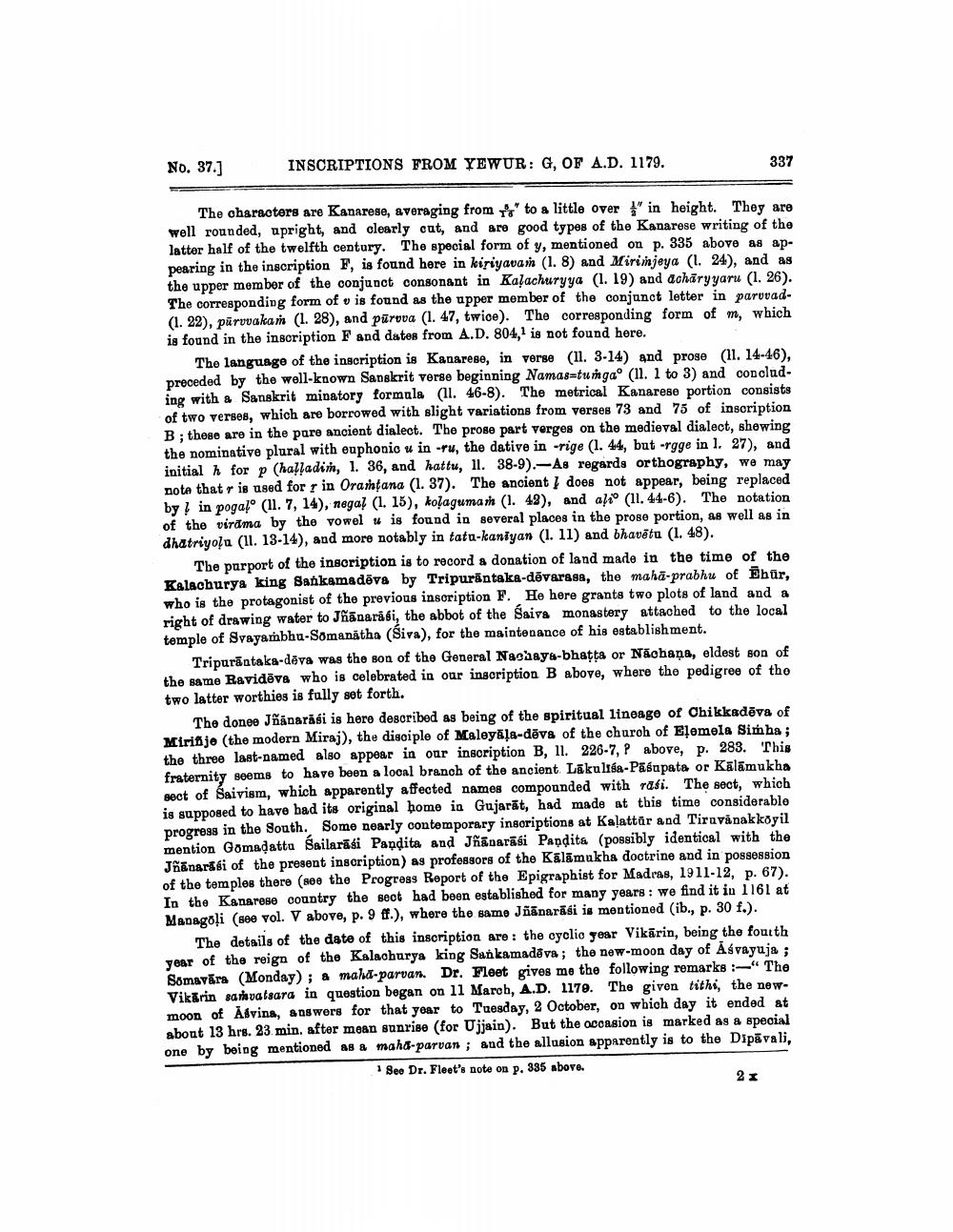________________
No. 37.]
INSCRIPTIONS FROM YEWUR: G, OF A.D. 1179.
337
The characters are Kanarese, averaging from A to a little over in height. They are well rounded, upright, and clearly cut, and are good types of the Kanarese writing of the latter half of the twelfth century. The special form of y, mentioned on p. 335 above as appearing in the inscription F, is found here in kisiyavar (1. 8) and Mirimjeya (1. 24), and as the upper member of the conjunct consonant in Kalachuryya (1. 19) and acharyyaru (1. 26). The corresponding form of v is found as the upper member of the conjunct letter in paruvad(1. 22), pūrvvaka (1. 28), and pūrova (1. 47, twice). The corresponding form of m, which is found in the inscription F and dates from A.D. 804,1 is not found here.
The language of the inscription is Kanarese, in verse (11. 3-14) and prose (11. 14-46), preceded by the well-known Sanskrit verse beginning Namasturgao (11. 1 to 3) and concluding with a Sanskrit minatory formula (II. 46-8). The metrical Kanareso portion consists of two verses, which are borrowed with slight variations from verses 73 and 75 of inscription B; these are in the pare ancient dialect. The proge part verges on the medieval dialect, shewing the nominative plural with euphonio u in -ru, the dative in -rige (1. 44, but rgge in l. 27), and initial h for p (hassadin, 1. 36, and hattu, 11. 38-9).-As regards orthography, we may note that r is used for r in Oranhtana (1. 37). The ancient ] does not appear, being replaced by l in pogas (11. 7, 14), negal (1. 15), kolaguman (1. 42), and alio (11. 44-6). The notation of the virama by the vowel 4 is found in several places in the prose portion, as well as in dhatriyoļa (II. 13-14), and more notably in tata-kaniyan (1. 11) and bhavētu (1. 48).
The purport of the inscription is to record a donation of land made in the time of the Kalachurya king Sankamadēvs by Tripurāntaka-dēvarasa, the mahā-prabhu of Ehür, who is the protagonist of the previous inscription F. He here grants two plots of land and a right of drawing water to Jhānarifi, the abbot of the Saiva monastery attached to the local temple of Svayambhu-Somanātha (Śiva), for the maintenance of his establishment.
Tripurantaka-deva was the son of the General Nachaya-bhatta or Nāchaņa, eldest son of the same Ravidēva who is celebrated in our inscription B above, where the pedigree of the two latter worthies is fully set forth.
The donee Jñanarăși is here described as being of the spiritual lineage of Chikkadēva of Mirifje (the modern Miraj), the disciple of Maley.la-dēvs of the churoh of Elemela Simha ; the three last-named also appear in our inscription B, II. 226-7, P above, p. 283. This fraternity seems to have been a loonl branch of the ancient Lākulisa-Pasupata or Kalamukha sect of Saivism, which apparently affected names compounded with rafi. The sect, which is supposed to have had its original bome in Gujarāt, had made at this time considerable progress in the South. Some nearly contemporary insoriptions at Kalattår and Tiruvanakkoyil mention Gomadatta Sailarăsi Pandita and Jñāparāśi Pandita (possibly identical with the Jñanarási of the present inscription) as professors of the Kālāmukha doctrine and in possession of the temples there (see the Progress Report of the Epigraphist for Madras, 1911-12, p. 67). In the Kanarese country the sect had been established for many years : we find it in 1161 at Madagoļi (80 vol. V above, p. 9 ff.), where the same Jñānarasi is mentioned (ib., p. 30 f.).
The details of the date of this inscription are: the cyclic year Vikārin, being the fourth year of the reign of the Kalacharya king Sankamadeva; the new-moon day of Asvayuja ; Somavāra (Monday); & mahd-parvan. Dr. Fleet gives me the following remarks :-" The Vikarin samvatsara in question began on 11 Maroh, A.D. 1179. The given tithin the new moon of Alvins, answers for that year to Tuesday, 2 October, on which day it ended at about 13 hrs. 23 min. after mean sunrise (for Ujjain). But the occasion is marked as a special one by being mentioned as a maha-parvan; and the allusion apparently is to the Dipävali, Seo Dr. Fleet's note on p. 335 above.
2




